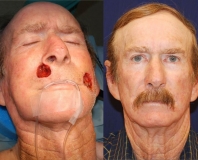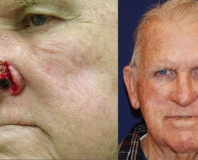Reconstructive Facial Plastic Surgery San Antonio
Patients present with facial plastic reconstructive needs after disease or trauma. As a double board-certified Facial Plastic Surgeon as well as a board-certified Head and Neck Surgeon, Dr. Shah specializes in Facial Reconstructive San Antonio techniques.
Skin Cancer Reconstruction (Mohs Reconstruction)
Patient 1. Patient presented with facial defects after skin cancer resection. To repair the defects, the patient’s own facial tissue has been rotated and inset. Surgical incisions are carefully designed to allow for maximum scar camouflage.
Patient 2. Patient presented with a nasal defect after skin cancer resection. A flap of the patient’s tissue was rotated to repair the nose. Incisions are carefully designed between facial aesthetic units for maximum scar camouflage.
Patient 3. Patient referred to Dr. Shah after a surgical procedure was performed elsewhere. Patient presents with a floppy right eyelid. Medically, this is known as ectropion. Dr. Shah performed an ectropion repair procedure to restore the eyelid to its normal position.
Visit our Photo Gallery for more before and afters of Facial Reconstructive Surgery San Antonio.
Skin cancer is one of the most frequently diagnosed cancers in the United States. Approximately one to two million people every year in America are diagnosed with skin cancer. Unfortunately, unlike other types of cancer, which are in decline, the incidence of skin cancer is increasing. There are various reasons for this, discussed below.
Types of skin cancer
The main types of skin cancer are: Basal Cell Carcinoma; Squamous Cell Carcinoma; and Melanoma. Basal Cell Carcinoma is the most common; however it is also the most treatable, with very high cure rates, especially when diagnosed and treated early. Basal Cell Carcinoma tends to stay local. Melanoma, however, while less common, is more dangerous, with the potential for distal metastasis.
Causes of skin cancer
Sun exposure is the most common etiology. Smoking aggravates the situation, particularly for lip cancers. Tanning salons are also a source of UV radiation. Age is risk factor, in that increased age implies greater cumulative sun exposure. Genetics and skin type play a role. Lighter-skinned individuals are at elevated risk.
Skin Cancer Prevention
- Avoid sun exposure, especially during the peak hours of 11am to 3pm.
- Wear sunscreen.
- Protective clothing: hats and long-sleeved shirts
- Avoid tanning salons
- Frequent self-examination
- Immediate evaluation with your primary care physician or dermatologist of any concerning skin lesion



